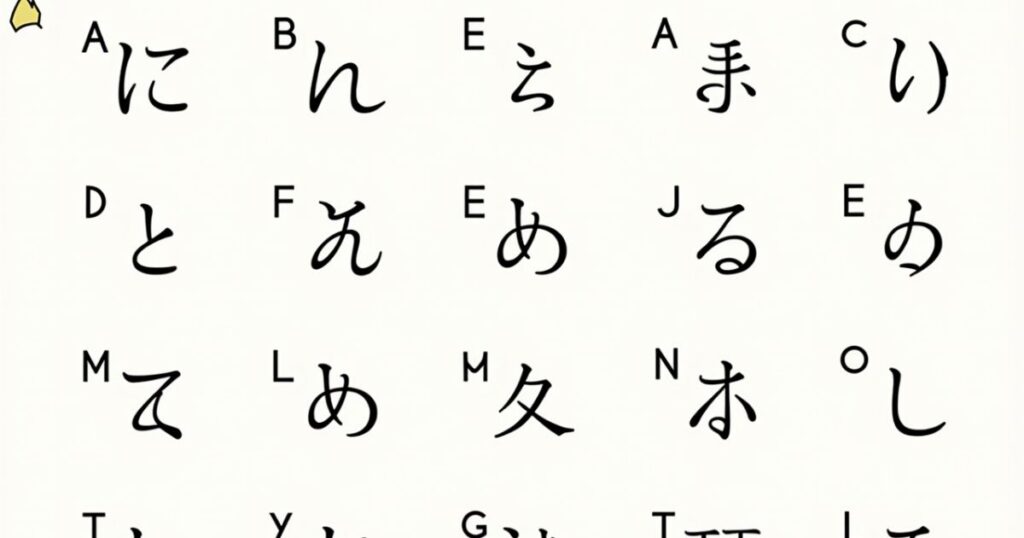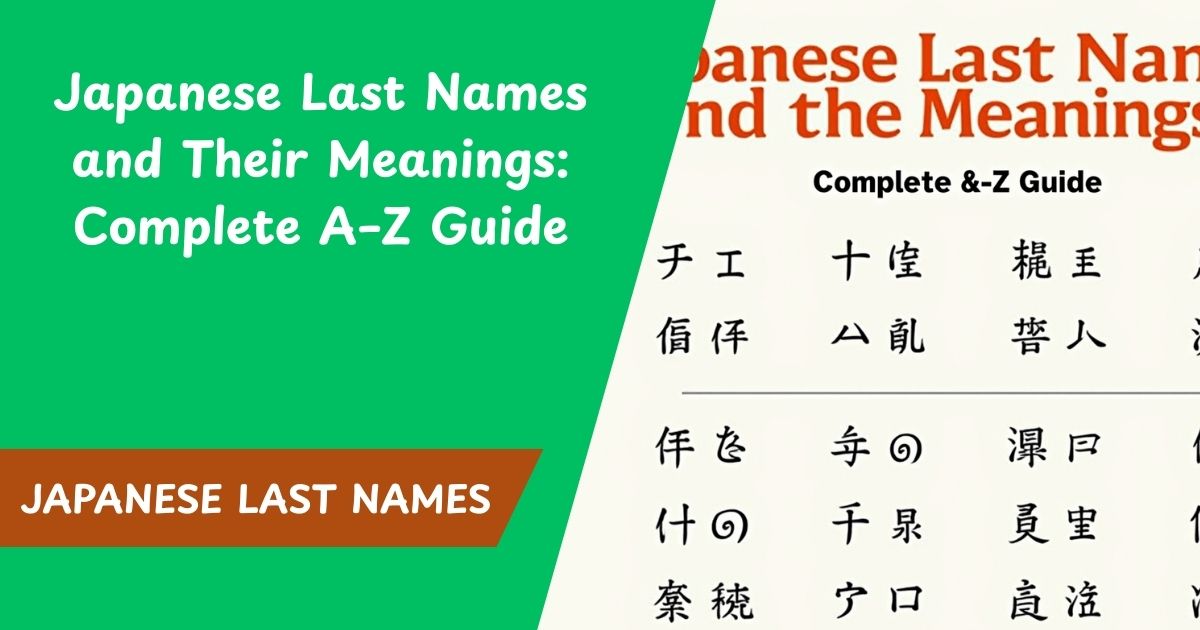Japanese surnames have a rich history, connecting families to nature, geography, and cultural traditions. They often reveal a lot about a person’s ancestry, occupation, or the place their family came from. With over 138,000 surnames in Japan, exploring these names can give fascinating insights into Japanese culture and heritage.
Whether you are tracing your roots or just curious, this guide lists over 500 Japanese last names, their meanings, and origins, from A to Z.
What Are Japanese Last Names?
Japanese last names, or surnames, are called myōji in Japanese. They usually come before the first name. For example, in Yamamoto Taro, “Yamamoto” is the family name.
Japan has over 138,000 surnames, according to the Enamdict Dictionary of Japanese Proper Names. There are also around 100,000 place names. Japanese families started using these names around 300 B.C., often based on jobs or locations.
Learning your last name can reveal a lot about your family history. Many names have meanings tied to nature, geography, or historical roles.
History of Japanese Surnames

Japanese surnames, called myōji, started around 300 B.C., often reflecting occupations or locations. By 250 AD, clans grew into small kingdoms, and rulers gave families designations based on status. This system was known as the Uji-Kabane system.
Early titles included:
- Omi – nobles of high rank
- Muraji – important occupational families
- Tomonomiyatsuko – government officials
Over centuries, surnames spread through birth, marriage, and clan connections, evolving into the names we see today.
How Japanese Names Work
In Japan:
- The family name comes first, followed by the given name.
- Names are written using kanji (characters) or hiragana.
- Kanji combinations can change the meaning, so some surnames have multiple interpretations.
When Japanese families moved abroad, many adopted the Western style, placing their given name first.
Most Popular Japanese Last Names
Here are some of the most common Japanese surnames:
- Sato – “help wisteria,” linked to imperial gardeners
- Suzuki – “bell tree,” shared by over 2 million people
- Takahashi – “tall bridge”
- Tanaka – “central rice field”
- Ito – “wisteria,” a royal symbol
- Watanabe – “crossing an edge,” originally a warrior clan
- Yamamoto – “origin of the mountain”
- Nakamura – “middle village”
- Kobayashi – “small forest”
- Kato – “increase the wisteria”
Nature-Inspired Japanese Surnames

Nature has always influenced Japanese culture. Many surnames come from trees, rivers, mountains, and flowers:
- Aoki – blue or green tree
- Fuji – wisteria
- Hara – meadow or field
- Ikeda – pond or water reservoir
- Kimura – tree or woods
- Kitagawa – north stream
- Matsumoto – pine tree
- Mori – forest
- Nakajima – island
- Ogawa – stream or river
- Yamada – mountain or rice field
- Yoshida – rice field
Regional Japanese Last Names
Many surnames reflect geographical locations:
- Endo – distant or far
- Furukawa – old river
- Hashimoto – bridge
- Hayashi – forest or grove
- Hori – ditch or canal
- Inoue – town above or northern village
- Matsushita – lower grove or pine tree
- Miura – seacoast
- Nakano – central field
- Oshima – large island
Japanese Last Names Influenced by Other Cultures
Some names show influence from Chinese or Korean culture, especially after Japan opened to foreign trade in the 19th century:
- Aito – Chinese constellation, means “to soar or fly”
- Hana – Korean for “first one”
- Jin – Korean surname meaning “truth”
- Kanei – “gold,” adopted by Korean immigrants
- Kaneko – Chinese zodiac sign of the rat
Complete A–Z List of 500+ Japanese Last Names

A
- Abe – “peace”
- Adachi – “base of the tree”
- Akagi – “red castle”
- Akamine – “red peak”
- Aki – “autumn”
- Akiyama – “autumn mountain”
- Amano – “heavenly field”
- Amari – “abundance”
- Amaya – “night rain”
B
- Baba – “horse place”
- Ban – “guard”
- Bando – “rice paddy region”
C
- Chiba – “thousand leaves”
- Chinen – “new field”
- Chino – “town field”
D
- Date – “rice field edge”
- Doi – “earth well”
- Domen – “gate field”
E
- Eguchi – “river mouth”
- Endo – “distant field”
- Enomoto – “entrance of the field”
- Eto – “shining wisteria”
F
- Fujii – “wisteria well”
- Fujikawa – “wisteria river”
- Fujimori – “wisteria forest”
- Fujimoto – “origin of wisteria”
- Fujimura – “wisteria village”
- Fujino – “wisteria field”
- Fujioka – “wisteria hill”
- Fujita – “field of wisteria”
- Fujiwara – “wisteria plain”
- Fukuda – “fertile rice field”
- Fukuhara – “fortunate plain”
- Fukui – “fortunate well”
- Fukumoto – “origin of fortune”
- Fukunaga – “long fortune”
- Fukushima – “fortunate island”
- Funai – “ship well”
- Furukawa – “old river”
- Furuta – “old rice field”
- Furutani – “old valley”
- Furuya – “old house”
- Fuse – “bridge”
G
- Gima – “island rice field”
- Go – “enlightened”
- Goda – “five rice fields”
- Goto – “five islands”
- Goya – “large valley”
H
- Hada – “smooth skin”
- Haga – “leafy field”
- Hagiwara – “bush plain”
- Hamada – “beach field”
- Hamamoto – “base of the beach”
- Hamasaki – “beach cape”
- Handa – “field rice”
- Hano – “flower field”
- Hara – “meadow”
- Harada – “meadow field”
- Hase – “long valley”
- Hasegawa – “long valley river”
- Hashimoto – “base of the bridge”
- Hata – “flag” or “loom”
- Hatanaka – “central rice field”
- Hattori – “half bird” (historically a ninja clan)
- Hayakawa – “fast river”
- Hayashi – “forest”
- Hayashida – “rice field in the forest”
- Higa – “sunny place”
- Higashi – “east”
- Higuchi – “river mouth”
- Hino – “sun field”
- Hirabayashi – “flat forest”
- Hirai – “flat well”
- Hirano – “flat plain”
- Hiraoka – “flat hill”
- Hirata – “flat rice field”
- Hirayama – “flat mountain”
- Hironaka – “wide field”
- Hirose – “wide river”
- Hirota – “wide rice field”
- Hoga – “distant valley”
I
- Ikeda – “pond” or “cistern”
- Inoue – “above the well” or “northern village”
- Ito – “wisteria”
K
- Kato – “increase wisteria”
- Kaneko – “golden child”
- Kanei – “gold”
- Kawai – “river side”
- Kawamoto – “origin of the river”
- Kawamura – “river village”
- Kido – “tree door”
- Kimura – “tree village”
- Kishimoto – “base of the tree”
- Kitagawa – “north river”
- Kobayashi – “small forest”
- Kodama – “spirit of the tree”
- Koga – “ancient river”
- Kojima – “small island”
- Komatsu – “small pine tree”
- Konno – “field of rice”
- Kondo – “near the temple”
- Kosaka – “small hill”
- Kotani – “small valley”
- Koyama – “small mountain”
M
- Maeda – “front rice field”
- Matsuda – “pine rice field”
- Matsumoto – “base of pine tree”
- Matsushita – “lower pine tree”
- Miura – “coast”
- Miyamoto – “base of the shrine”
- Miyazaki – “shrine cape”
- Morita – “forest rice field”
- Mori – “forest”
- Morishita – “below the forest”
- Murakami – “village upper”
- Murata – “village rice field”
N
- Nakagawa – “central river”
- Nakajima – “central island”
- Nakano – “central field”
- Nakamura – “middle village”
- Nakashima – “central island”
- Nakata – “central rice field”
- Nakanishi – “central west”
- Nishikawa – “western river”
- Nishimura – “western village”
- Nishio – “western tail”
O
- Ogawa – “small river”
- Ohara – “big meadow”
- Okada – “rice field hill”
- Okamoto – “hill base”
- Okazaki – “hill cape”
- Omura – “big village”
- Oshima – “large island”
S
- Saito – “wisteria”
- Saito – variation of Ito
- Sakamoto – “hill base”
- Sakurai – “cherry blossom well”
- Sasaki – “wisteria blossom”
- Sato – “help wisteria”
- Sawada – “swamp rice field”
- Shibata – “brushwood rice field”
- Shimizu – “pure water”
- Sugawara – “sedge field”
- Sugimoto – “base of the cedar tree”
- Suzuki – “bell tree”
T
- Takahashi – “tall bridge”
- Takeda – “rice field of the tall”
- Tanaka – “central rice field”
- Taniguchi – “valley entrance”
- Tanimura – “valley village”
- Tsuchiya – “earth valley”
W
- Wada – “rice field valley”
- Wakamatsu – “young pine tree”
- Watanabe – “crossing an edge”
Y
- Yamada – “mountain rice field”
- Yamaguchi – “mountain entrance”
- Yamamoto – “origin of the mountain”
- Yanagisawa – “willow swamp”
- Yasuda – “peaceful rice field”
- Yoshida – “rice paddy”
- Yoshikawa – “fortunate river”
Z
- Zaizen – “front garden”
- Zaitsu – “wealthy place”
- Zenko – “good child”
Fun Facts About Japanese Surnames
- Some names are unique to regions, others are widespread.
- Many surnames connect to nature, occupations, or ancient clans.
- Japanese names can reveal social status and history.
FAQs
What is the most common Japanese surname?
Sato is the most common, followed by Suzuki and Takahashi.
How do Japanese surnames differ by region?
Some surnames are widespread, while others are unique to specific prefectures.
Can I trace my ancestry through Japanese surnames?
Yes, surnames often link families to clans, regions, and occupations.
Why do some surnames have multiple meanings?
Different kanji combinations can change the meaning of a name.
Conclusion
Japanese last names are more than labels. They tell stories about family, nature, history, and culture. Exploring your surname can help you connect with your roots and understand the meaning behind your family name.
Start exploring your Japanese heritage today and uncover the story behind your last name!

